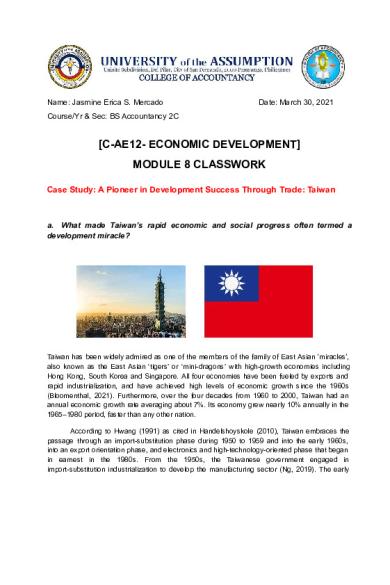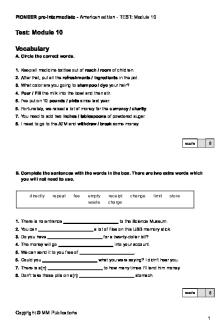A Pioneer in Development Success Through Trade Taiwan PDF

| Title | A Pioneer in Development Success Through Trade Taiwan |
|---|---|
| Author | Jazzy Mercado |
| Course | Bachelor of Science in Accountancy |
| Institution | University of the Assumption |
| Pages | 4 |
| File Size | 200.8 KB |
| File Type | |
| Total Downloads | 393 |
| Total Views | 598 |
Summary
Name: Jasmine Erica S. Mercado Date: March 30, 2021Course/Yr & Sec: BS Accountancy 2C[C-AE12- ECONOMIC DEVELOPMENT]MODULE 8 CLASSWORKCase Study: A Pioneer in Development Success Through Trade: Taiwana. What made Taiwan’s rapid economic and social progress often termed adevelopment miracle?Taiwan...
Description
Name: Jasmine Erica S. Mercado
Date: March 30, 2021
Course/Yr & Sec: BS Accountancy 2C
[C-AE12- ECONOMIC DEVELOPMENT] MODULE 8 CLASSWORK Case Study: A Pioneer in Development Success Through Trade: Taiwan
a. What made Taiwan’s rapid economic and social progress often termed a development miracle?
Taiwan has been widely admired as one of the members of the family of East Asian 'miracles', also known as the East Asian ‘tigers’ or ‘mini-dragons’ with high-growth economies including Hong Kong, South Korea and Singapore. All four economies have been fueled by exports and rapid industrialization, and have achieved high levels of economic growth since the 1960s (Bloomenthal, 2021). Furthermore, over the four decades from 1960 to 2000, Taiwan had an annual economic growth rate averaging about 7%. Its economy grew nearly 10% annually in the 1965–1980 period, faster than any other nation. According to Hwang (1991) as cited in Handelshoyskole (2010), Taiwan embraces the passage through an import-substitution phase during 1950 to 1959 and into the early 1960s, into an export orientation phase, and electronics and high-technology-oriented phase that began in earnest in the 1980s. From the 1950s, the Taiwanese government engaged in import-substitution industrialization to develop the manufacturing sector (Ng, 2019). The early
mobilization of Taiwan's agricultural sector, which provided the required domestic savings and became the first focus of Taiwan's export orientation, was also a substantial part of Taiwan’s success story. According to Ranis (2007), the export drive was built on the shift from rice and sugar cultivation to the production of mushrooms and asparagus - non-traditional crops that were much more labour-intensive and susceptible to labour-using technology (for example, the number of working days per hectare per annum increased from 170 in the early post-war period to 260 by the early 1960s). Taiwan had an agricultural economy up to 1962 (Handelshoyskole, 2010). Furthermore, the story of Taiwan’s successful development experience is due, more than anything else, to the effectiveness of "Industrial Policy" rather than free market operations. Taiwan encountered a number of socioeconomic issues as it transitioned from an agricultural to an industrial economy. The most pressing issue was the surplus labor created by agriculture which is why over time, the government recognized the economic potential of export-led growth and pursued an outward strategy. By the period of 1980s, government officials strategized to develop those industries which produced high value-added goods for exports (such as the mechanical engineering and computer electronics industries) which is how technology- and capital-intensive industries replaced the labour-intensive industries to be the mainstay of the industrial sector. The development of Taiwan’s high-tech industries is beneficial as it made Taiwan at this point, emerge as an economic power, with a mature and diverse economy, a strong presence in international markets, and massive foreign exchange reserves. Taiwan’s development has also been explained in more number of factors including an emphasis on education, early and thorough land reform, very high rate of saving and investment, diffusion of commercial ideas , the free market’s release of human energies and creativity, and extensive infrastructure development (Taiwan - Inside the Miracle, n.d.).
b. Would it be possible for the Philippines to succeed economically and socially through international trade? I believe, yes it would be possible for the Philippines to succeed economically and socially through international trade. If our country will be open to international trade, it will grow more rapidly, drive innovation, increase productivity, and provide Filipinos with higher incomes and more opportunities. Furthermore, international trade allows developing countries to produce more of the goods in which they have a comparative advantage (Suman, n.d.). Consequently, production, income and employment in these countries increase leading to increase in demand. This increased demand is partially met by domestic production and partially by foreign imports. In this way, exports and imports of various products can help in breaking the vicious circle of poverty in our country. Thus, it accelerates the rate of economic development automatically in the economy.
Reference: Bloomenthal, A. (2021). Four Asian Tigers. Retrieved from https://www.investopedia.com/terms/f/four-asian-tigers.asp Taiwan Inside the Miracle: A Development http://theunbrokenwindow.com/Development/Taiwan%20Case%20Study.pdf
Success
Story.
Retrieved
from
Ng, J. (2019). What caused the Taiwan economic miracle? https://www.jchistorytuition.com.sg/jc-h2-history-tuition-notes-what-caused-the-taiwan-economic-miracle/
Retrieved
from
Handelshoyskole, N. (2010). What can explain Taiwan’s growth miracle over the period 1950-2000? Export promotion, Capital accumulation, Policies and Institutions. Retrieved from https://openaccess.nhh.no/nhh-xmlui/bitstream/handle/11250/168523/Braaten%202010.pdf?sequence=1&isAllowed=y Suman, S. (n.d.). Beneficial Effects of International Trade | Economic Development. https://www.economicsdiscussion.net/international-trade/beneficial-effects-of-international-trade-economic-development/13171...
Similar Free PDFs

Spread of Islam Through Trade
- 1 Pages

A Guide for Success in Math 1065
- 1 Pages

Pioneer Rx Guide (for pioneer rx)
- 14 Pages

PR Pioneer: Muriel Fox
- 5 Pages

Grace Coyle: Pioneer Essay
- 6 Pages

NGT Pioneer MCQs - mcq
- 16 Pages
Popular Institutions
- Tinajero National High School - Annex
- Politeknik Caltex Riau
- Yokohama City University
- SGT University
- University of Al-Qadisiyah
- Divine Word College of Vigan
- Techniek College Rotterdam
- Universidade de Santiago
- Universiti Teknologi MARA Cawangan Johor Kampus Pasir Gudang
- Poltekkes Kemenkes Yogyakarta
- Baguio City National High School
- Colegio san marcos
- preparatoria uno
- Centro de Bachillerato Tecnológico Industrial y de Servicios No. 107
- Dalian Maritime University
- Quang Trung Secondary School
- Colegio Tecnológico en Informática
- Corporación Regional de Educación Superior
- Grupo CEDVA
- Dar Al Uloom University
- Centro de Estudios Preuniversitarios de la Universidad Nacional de Ingeniería
- 上智大学
- Aakash International School, Nuna Majara
- San Felipe Neri Catholic School
- Kang Chiao International School - New Taipei City
- Misamis Occidental National High School
- Institución Educativa Escuela Normal Juan Ladrilleros
- Kolehiyo ng Pantukan
- Batanes State College
- Instituto Continental
- Sekolah Menengah Kejuruan Kesehatan Kaltara (Tarakan)
- Colegio de La Inmaculada Concepcion - Cebu









